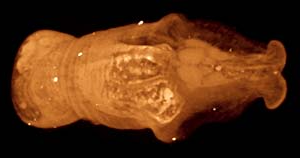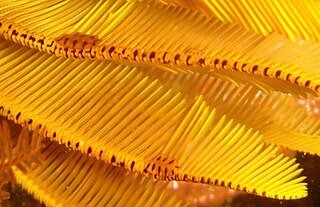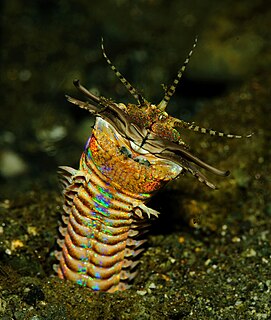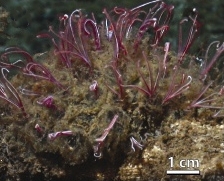
Siboglinidae, also known as the beard worms, is a family of polychaete annelid worms whose members made up the former phyla Pogonophora and Vestimentifera. They are composed of about 100 species of vermiform creatures and live in thin tubes buried in sediments at ocean depths from 100 to 10,000 m (300–32,800 ft). They can also be found in association with hydrothermal vents, methane seeps, with sunken plant material or whale carcasses.

The Echiura, or spoon worms, are a small group of marine animals. Once treated as a separate phylum, they are now considered to be a subclass of Polychaeta, the bristle worms. Polychaete worms typically have their bodies divided into segments, but echiurans have secondarily lost their segmentation. The majority of echiurans live in burrows in soft sediment in shallow water, but some live in rock crevices or under boulders, and there are also deep sea forms. More than 230 species have been described.

The Polychaeta, also known as the bristle worms or polychaetes, are a paraphyletic class of annelid worms, generally marine. Each body segment has a pair of fleshy protrusions called parapodia that bear many bristles, called chaetae, which are made of chitin. As such, polychaetes are sometimes referred to as bristle worms. More than 10,000 species are described in this class. Common representatives include the lugworm and the sandworm or clam worm Alitta.

Panarthropoda is a proposed animal clade combining the extant phyla Arthropoda, Tardigrada and Onychophora, Not all studies support it, but most do, including neuroanatomical, mitogenomic and palaeontological studies. Originally, they were considered to be closely related to the annelids, grouped together as the Articulata, but newer studies place them among the Ecdysozoa.

Kinorhyncha is a phylum of small marine invertebrates that are widespread in mud or sand at all depths as part of the meiobenthos. They are also called mud dragons.

Xenoturbella is a genus of very simple bilaterians up to a few centimeters long. It contains a small number of marine benthic worm-like species.

Aplacophora is a monophyletic group of small, deep-water, exclusively benthic, marine molluscs found in all oceans of the world. All known modern forms are shell-less: only some extinct primitive forms possessed valves. The group comprises the two clades Solenogastres (Neomeniomorpha) and Caudofoveata (Chaetodermomorpha), which between them contain 28 families and about 320 species. The aplacophorans are traditionally considered ancestral to the other mollusc classes. However, the relationship between the two aplacophoran groups and to the other molluscan classes and to each other is as yet unclear.

Scalidophora is a group of marine pseudocoelomate protostomes that was proposed on morphological grounds to unite three phyla: the Kinorhyncha, the Priapulida and the Loricifera. The three phyla have four characters in common — chitinous cuticle that is moulted, rings of scalids on the introvert, flosculi, and two rings of introvert retracts. However, the monophyly of the Scalidophora is not supported by molecular studies, where the position of the Loricifera was uncertain or as sister to the Panarthropoda. Both studies supported a reduced Scalidophora comprising the Kinorhyncha and Priapulida as sister phyla. Their closest relatives are the Panarthropoda, Nematoda and Nematomorpha; thus they are placed in the group Ecdysozoa.

The Myzostomida or Myzostomatida are an order of small marine worms, which are parasitic on echinoderms, mostly crinoids. These highly unusual and diverse annelids were first discovered by Friedrich Sigismund Leuckart in 1827.
Chaetopterus pugaporcinus, commonly known as the pigbutt worm or flying buttocks, is a species of worm first described by scientists at the Monterey Bay Aquarium Research Institute in 2007. The worm is round in shape, approximately 10 to 20 millimeters in length, and bears a strong resemblance to a disembodied pair of buttocks. Because of this, it was given a Latin species name that roughly translates to "resembling a pig's rear."

The Chaetopteridae are a family of marine filter-feeding polychaete worms that live in vertical or U-shaped tubes in tunnels buried in the sedimentary or hard substrate of marine environments. The worms are highly adapted to the hard tube they secrete. Inside the tube the animal is segmented and regionally specialized, with highly modified appendages on different segments for cutting the tunnel, feeding, or creating suction for the flow of water through the tube home. The modified segments for feeding are on the 12th segment from the head for members of this family.

Eunice is a genus in the polychaete family Eunicidae. Individuals grow to a length of between 0.5 and 300 cm. Their bodies have multiple segments. They have two eyes and five tentacles. They have well-developed sense organs and relatively large brains. Their color is dark purple-brown to red-brown with a white ring at the fourth segment. They are found in oceans and seas around the world. They have an evertible proboscis with distinctive mouthparts, some of which comprise two rows of maxilliary plates in a radula-like fashion.

Hesionidae are a family of phyllodocid "bristle worms". They are marine organisms. Most are found on the continental shelf; Hesiocaeca methanicola is found on methane ice, where it feeds on bacterial biofilms.
The Spiralia are a morphologically diverse clade of protostome animals, including within their number the molluscs, annelids, platyhelminths and other taxa. The term Spiralia is applied to those phyla that exhibit canonical spiral cleavage, a pattern of early development found in most members of the Lophotrochozoa.
Osedax mucofloris is a species of bathypelagic Polychaetes that is reported to sustain itself on the bones of dead whales. Translated from the mixed Greek and Latin used in scientific names, "Osedax mucofloris" literally means "snot-flower bone-eater", though the less-accurate "bone-eating snot-flower worm" seems to be the form actually used. The species is found in North East Atlantic where it is abundant.

Alitta succinea is a species of marine annelid in the family Nereididae. It has been recorded throughout the North West Atlantic, as well as in the Gulf of Maine and South Africa.

Palpata is a subclass of polychaete worm. Members of this subclass are mostly deposit feeders on marine detritus or filter feeders. Palpata has become superfluous with the elevation of Canalipalpata to subclass.

Amphinomidae, also known as the bristle worms or sea mice, are a family of marine polychaetes, many species of which bear chaetae mineralized with carbonate. The best-known amphinomids are the fireworms, which can cause great pain if their toxin-coated chaetae are touched or trodden on. Their relationship to other polychaete groups is somewhat poorly resolved.

Osedax frankpressi is a species of bathypelagic polychaete worm that lives on the seabed and sustains itself on the bones of dead whales. It can be found in the East North Pacific Ocean. The specific epithet is named in honor of Frank Press "for his distinguished service to science".

















